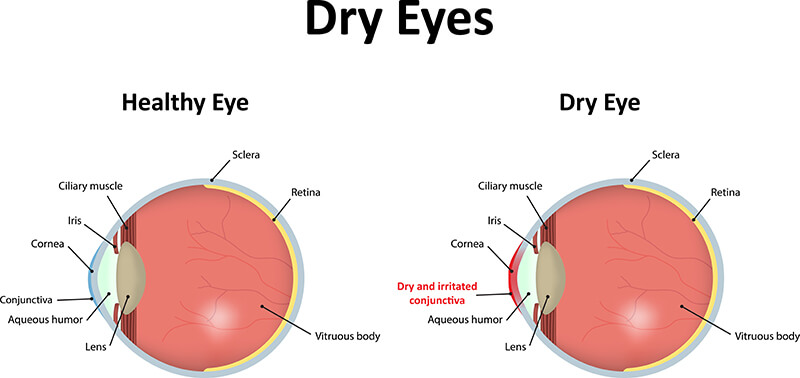Suffering from dry, watering eyes is a frustrating way to live day to day. Many people go through their daily activities thinking that their chronically dry eyes are normal. If you are one of the millions of people suffering from dry eye syndrome, you are not alone. If you’re ready to do something about it, that’s where we come in!
What is Dry Eye Syndrome?
Dry eye syndrome occurs when the tear film, responsible for keeping our eye nourished and comfortable, is unbalanced. Dry eye syndrome can be caused by a lack of tear production, or a lack of quality tear production. The first is self-explanatory – less tear equals drier eyes. The second is a bit more complicated. To understand why some people have lower quality tears, you must first learn about the different components of the tear film.
Tear Layers
The tear film is made up of three distinct layers:
Mucin: The innermost mucin layer layer is responsible for allowing the watery layer to spread evenly over the cornea. This helps the eye remain moist and lubricated, as well as helping the tears stick to the cornea.
Water: The middle water, or aqueous, layer is responsible for lubricating the eyes. It also aids in washing away any particles that may enter the eye and prevent infection.
Oil: The oil, or lipid, layer is the outermost layer of the tear film. Its purpose is to seal the tear film and keep it from evaporating too quickly.
Most people with dry eye syndrome suffer from a specific type: evaporative dry eye. Evaporative dry eye occurs when the meibomian gland (responsible for the production of the oil layer) becomes dysfunctional. Meibomian gland dysfunction means that there is little to no oil being produced for the tear film. Therefore, the inner water layer evaporates quickly, producing those frustrating dry eye symptoms. The tear gland may try to compensate by overproducing the water layer causing excessive “wetness” even though your eyes are dry.
Dry Eye Syndrome Diagnosis
Dry eye syndrome is primarily diagnosed through a comprehensive eye exam. There are several different tests that can be performed to diagnose dry eye syndrome. These tests delve deeper into patient history and what may have caused the dry eye symptoms to appear, as well as evaluations of the eyelids and the cornea. A crucial part of this testing is the measurement of the quality and quantity of the tears, which checks for any abnormalities found in the tear samples.

Dry Eye Syndrome Treatments
 Although dry eye syndrome is considered a chronic condition that has no cure, there are several treatment options available to make living with the condition easier. The first approach involves using over-the-counter artificial tears. These common artificial tears help fill in for natural tear production, temporarily alleviating symptoms. If artificial tears don’t help, other treatment options like permanent punctal plugs may help. These tiny plugs help block the tear ducts, keeping tears in the eye longer. Another option to keep in mind is increasing tear production by using prescription eye drops. These eye drops can help keep your eyes moist, helping your chronic dry eye.
Although dry eye syndrome is considered a chronic condition that has no cure, there are several treatment options available to make living with the condition easier. The first approach involves using over-the-counter artificial tears. These common artificial tears help fill in for natural tear production, temporarily alleviating symptoms. If artificial tears don’t help, other treatment options like permanent punctal plugs may help. These tiny plugs help block the tear ducts, keeping tears in the eye longer. Another option to keep in mind is increasing tear production by using prescription eye drops. These eye drops can help keep your eyes moist, helping your chronic dry eye.
For those who have been diagnosed with dry eye, lifestyle changes may help tremendously. If you work in front of a computer, make sure to take a break from looking at the screen every 20 minutes or so. Regularly blinking, wearing sunglasses outdoors, and taking nutritional supplements that contain fatty acids are also easy ways to keep symptoms under control.
Other Causes of Tearing
Blocked Tear Duct
Sometimes excessive tearing may not be from dry eyes but from a blocked outflow of tears. Special testing that is done in the office can check for this condition. Depending on the cause of the blockage, your doctor may prescribe prescription medicines or refer you to a fellowship trained Oculopastic specialist for a surgical evaluation.
External DCR
Looking for more information or a consultation? Give us a call to schedule an appointment with one of our doctors to get relief from your chronic dry eye!

